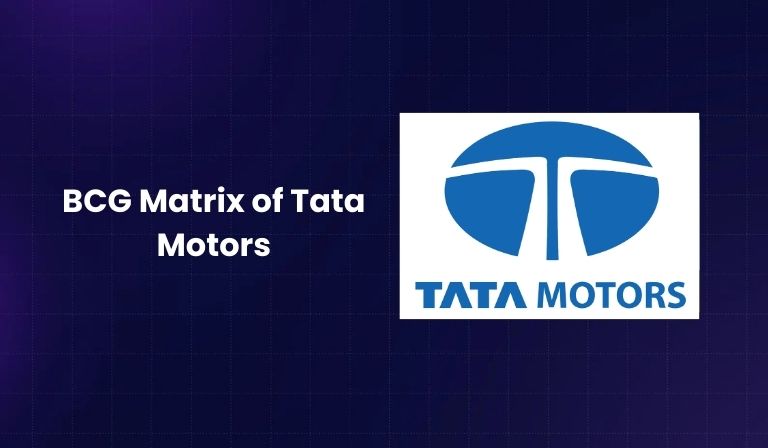Summary
Tata Motors is one of India’s most iconic automobile companies and a global player in the automotive industry. With a product portfolio ranging from passenger cars, SUVs, electric vehicles, commercial vehicles, and luxury cars (through Jaguar Land Rover), Tata Motors caters to diverse consumer segments.
But with such a broad portfolio, how does Tata Motors decide which products to prioritize, invest in, or phase out? The BCG Matrix offers a structured way to analyze the company’s products based on market growth rate and market share.
In this blog, we will explore the complete BCG Matrix of Tata Motors, categorizing its products into Stars, Cash Cows, Question Marks, and Dogs, and understand the strategic implications for the company’s future.
What is the BCG Matrix?
The Boston Consulting Group (BCG) Matrix is a portfolio management framework that classifies products or business units into four quadrants based on:
- Market Growth Rate (Industry attractiveness)
- Relative Market Share (Competitive strength)
The four quadrants are:
- Stars (High Growth, High Market Share): Fast-growing products with leadership positions. They require heavy investment but can become future profit drivers.
- Cash Cows (Low Growth, High Market Share): Mature products with stable market dominance. They generate steady profits with little investment.
- Question Marks (High Growth, Low Market Share): Products in booming industries but with small market share. They need careful evaluation—invest or divest.
- Dogs (Low Growth, Low Market Share): Weak products with low growth and low share. They often drain resources and may need to be phased out.
For Tata Motors, this matrix helps understand how its passenger, commercial, and luxury vehicle segments fit into its long-term strategy.
Tata Motors’ Product Portfolio Overview
Tata Motors operates in several segments:
- Passenger Vehicles (PV): Tata Tiago, Tigor, Altroz, Punch, Harrier, Safari, Nexon (ICE and EV).
- Electric Vehicles (EV): Nexon EV, Tigor EV, Tiago EV, Punch EV (new entrant).
- Commercial Vehicles (CV): Buses, trucks, small commercial vehicles (Tata Ace, Tata 407, Prima trucks).
- Luxury Vehicles (Jaguar Land Rover – JLR): Range Rover, Jaguar sedans, Land Rover SUVs.
- Other Ventures: Defense vehicles, electric mobility solutions, and future autonomous vehicle projects.
This diverse portfolio makes Tata Motors an ideal candidate for a BCG Matrix analysis.
BCG Matrix of Tata Motors: Complete Analysis
1. Stars (High Growth, High Market Share)
These are Tata Motors’ growth engines, operating in booming sectors with strong market presence.
Electric Vehicles (Nexon EV, Tigor EV, Tiago EV, Punch EV)
- Tata Motors is the market leader in India’s EV space with over 70% market share.
- Nexon EV is India’s most popular electric SUV, while Tiago EV caters to affordable EV demand.
- EV market in India is growing at a 30–40% CAGR, supported by government policies (FAME-II, subsidies).
- Tata’s focus on charging infrastructure partnerships further strengthens its dominance.
Why a Star? EV is a high-growth industry, and Tata Motors already leads with significant market share.
Tata Nexon (ICE + EV)
- Nexon has become one of India’s top-selling SUVs.
- Available in both ICE and EV versions, it caters to both traditional and future markets.
- Consistent design upgrades and safety (5-star GNCAP rating) make it a consumer favorite.
Why a Star? Positioned in India’s fastest-growing SUV segment with strong dominance.
Jaguar Land Rover (Land Rover SUVs)
- Globally, Land Rover SUVs are strong contenders in the luxury SUV segment.
- High growth in global luxury vehicle markets, especially in China, US, and Middle East.
- Despite competition (BMW, Mercedes, Audi), Land Rover maintains brand strength.
Why a Star? Land Rover remains a global growth driver with premium positioning.
2. Cash Cows (Low Growth, High Market Share)
These are mature products that generate steady revenues with less investment.
Commercial Vehicles (Trucks, Buses, Tata Ace, 407, Prima series)
- Tata Motors is India’s largest CV manufacturer, with leadership in trucks and buses.
- CV industry growth is stable, driven by logistics, e-commerce, and infrastructure.
- The Tata Ace (“Chhota Hathi”) has become iconic in small CV category.
Why a Cash Cow? Mature but dominant segment, providing steady cash flow.
Tata Safari & Harrier (SUVs)
- Strong presence in premium SUV market.
- The SUV segment is growing but not as fast as compact SUVs (like Nexon, Punch).
- Safari has legacy value, while Harrier competes with Hyundai Creta, Kia Seltos, MG Hector.
Why a Cash Cow? Stable demand and high market share in mid-size SUV segment.
Jaguar Cars (Luxury Sedans like XF, XE, F-Type)
- Jaguar sedans face stagnation in global luxury car demand.
- Market for luxury sedans is shrinking as SUVs dominate.
- Still generate revenue due to brand heritage.
Why a Cash Cow? Mature market, consistent revenues, but limited growth.
3. Question Marks (High Growth, Low Market Share)
These are Tata Motors’ strategic dilemmas—they are in booming markets but lag in share.
Tata Altroz (Premium Hatchback)
- Competes with Maruti Baleno, Hyundai i20.
- The hatchback market is large but dominated by rivals.
- Altroz offers safety and design but hasn’t captured significant share.
Why a Question Mark? Huge market, but Tata struggles against Maruti and Hyundai.
Tata Punch (Micro SUV)
- Micro SUV market is growing rapidly.
- Punch has shown promise, but competition from Maruti Fronx, Hyundai Exter is tough.
Why a Question Mark? High growth market, but Tata needs aggressive push to dominate.
Jaguar EVs (I-PACE)
- Jaguar I-PACE competes with Tesla and Mercedes EQC in luxury EV space.
- Global EV market is booming, but Jaguar lags behind.
Why a Question Mark? Potential is massive, but market share is small.
International CV Markets (Export Buses, Trucks)
- Tata Motors exports commercial vehicles but faces global giants like Volvo, Scania, Daimler.
- Growth potential is high, but Tata’s global presence is limited.
Why a Question Mark? Opportunity exists, but share is small.
4. Dogs (Low Growth, Low Market Share)
These are weak products with low share and limited growth.
Tata Nano
- Marketed as the “world’s cheapest car,” Nano failed due to poor positioning.
- Discontinued in 2018 after low demand.
Why a Dog? Low growth, no market share, and brand failure.
Tata Bolt & Zest
- Compact sedan/hatchback models that failed to make impact.
- Overshadowed by Maruti Dzire, Hyundai i20, Honda Amaze.
Why a Dog? Weak presence, eventually phased out.
Jaguar XJ
- Luxury sedan segment has been declining globally.
- The Jaguar XJ lost relevance and was discontinued.
Why a Dog? Market shift towards SUVs ended its run.
Aria / Hexa (MPVs)
- Tata’s attempts in MPV segment didn’t succeed.
- Faced competition from Toyota Innova and Mahindra Xylo.
Why a Dog? Low sales, eventually discontinued.
Insights from Tata Motors’ BCG Matrix
- Stars (Nexon, EVs, Land Rover SUVs): Future drivers of Tata’s growth. Heavy investment required.
- Cash Cows (CVs, Safari, Harrier, Jaguar Sedans): Provide stable revenues to fund innovation.
- Question Marks (Altroz, Punch, Jaguar EVs, exports): Need strategic focus—either scale up or withdraw.
- Dogs (Nano, Hexa, Bolt, XJ): Failed experiments that highlight risks of wrong positioning.
Advantages of BCG Matrix for Tata Motors
- Clarity in Investment: Helps Tata decide whether to invest more in EVs or rationalize weaker models.
- Balanced Portfolio: Ensures profits from CVs fund EV development.
- Long-Term Planning: Shows where Tata needs to innovate (EVs, SUVs) vs. divest (sedans, failed cars).
- Simplification: Offers a simple way to manage a complex global portfolio.
Limitations of BCG Matrix for Tata Motors
- Oversimplified: Doesn’t capture industry dynamics like regulations, fuel prices, or consumer trends.
- Ignores Synergy: For example, CV profits fund EVs, but matrix treats them separately.
- Dynamic Market: Auto industry changes fast—today’s Cash Cow (SUVs) could be tomorrow’s Dog.
- External Factors: Competition from Tesla, Maruti, Hyundai, government EV policies are ignored.
Conclusion
The BCG Matrix of Tata Motors shows how the company balances legacy strength in CVs with future bets in EVs and SUVs:
- Stars (EVs, Nexon, Land Rover SUVs): High-growth and dominant, needing heavy investment.
- Cash Cows (CVs, Safari, Harrier, Jaguar sedans): Provide stable cash flows.
- Question Marks (Altroz, Punch, Jaguar EVs): Need sharper strategies to capture growth.
- Dogs (Nano, Bolt, Hexa, Jaguar XJ): Past failures and discontinued models.
Tata Motors is smartly positioning itself as a leader in EVs and SUVs, while leveraging CV cash flows. The company’s ability to scale EV adoption and global expansion will determine its success in the next decade.
FAQs
What is Tata Motors’ biggest Cash Cow?
Its commercial vehicle (CV) segment, including Tata Ace and Prima trucks, generates stable profits in a mature market.
Why are Tata EVs considered Stars?
Because Tata leads India’s EV market with over 70% share in a rapidly growing industry.
Which Tata Motors products fall under Question Marks?
Altroz, Punch, Jaguar I-PACE, and international CV exports.
Why did Tata Nano fail and become a Dog?
It was marketed as the “cheapest car,” which hurt its aspirational appeal, leading to poor demand.
How does the BCG Matrix help Tata Motors?
It helps Tata allocate resources, decide future investments (like EVs), and manage weak products.
A digital marketer with a strong focus on SEO, content creation, and AI tools. Creates helpful, easy-to-understand content that connects with readers and ranks well on search engines. Loves using smart tools to save time, improve content quality, and grow online reach.

